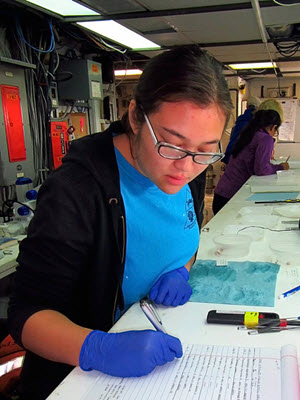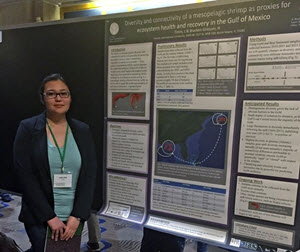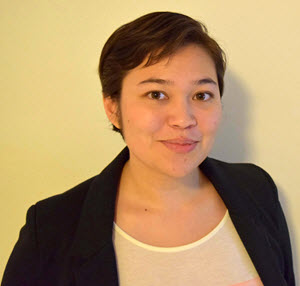
Laura Timm keeps careful records of collected species, including the number of individuals and how they are preserved. (Photo credit: Dr. Dante Fenolio)
Laura Timm examines connections among shellfish ecology and evolution to help scientists understand how the Deepwater Horizon oil spill affected certain Gulf of Mexico species: “My work focuses on establishing pre-spill baselines and comparing them to samples taken 3-7 years after the oil spill, providing a timeline of crustacean recovery.”
Pursuing a Ph.D. in biology at Florida International University (FIU), Laura is a GoMRI scholar with the DEEPEND consortium. She talks about her journey from her landlocked childhood to a life exploring Gulf health and resilience.
Her Path
A Minnesota native, Laura credits summer trips to California with igniting her passion for marine science: “I would spend hours exploring tide pools, completely enthralled by the biodiversity I saw there, which was unlike anything I had seen in my home state.”
A high school genetics class inspired her to pursue a deeper, molecular-level understanding of organisms and systems, which she did at Texas A & M University at Galveston. There, she completed a research project on the Sipunculan worms’ genetic connectivity in the Sea of Japan, working in Dr. Anja Schulze’s phylogeny and population genetics lab. “Studying genetics in marine invertebrates was the perfect combination for me,” said Laura.

Laura holds samples of A. purpurea and S. robusta, two shrimp species she is studying, and prepares them for ddRAQseq analysis. (Photo credit: Dr. Dante Fenolio)
Laura spent a year after graduation as a volunteer coordinator for a local nonprofitSMART Family Literacy program and as an after-school programs instructor for the Galveston Independent school district. She coached soccer, led a film class, tutored, and developed enrichment courses. These experiences sparked her desire to further others’ learning.
Laura wanted to continue her marine genetics studies and her newly-discovered education interest, so she searched graduate programs that might offer both. She and Dr. Heather Bracken-Grissom at FIU began communicating after learning they had similar interests in Gulf health and marine education. Laura began her Ph.D. program and assisted Dr. Bracken-Grissom in writing the DEEPEND grant proposal for oil spill research, which GoMRI funded in 2015.
Her Work
Laura studies nine crustacean species to explore Gulf genetic diversity and population connectivity, seeking answers to several questions: What kind of genetic diversity can be found in the deep Gulf? How well are the distinct populations connecting and communicating throughout the larger ecosystem? How has the oil spill impacted diversity and connectivity? What recovery, if any, can be seen since the spill? And, is the Gulf a genetically closed system or is there migration into and out of the Gulf?

A.purpurea, a Gulf shrimp species that that spews a glowing bioluminescent cloud from its mouth when attacked, is one of the crustaceans Laura and Team Crusty are studying. (Photo credit: Dr. Dante Fenolio)
“I’m particularly interested in diversity because this can be a good proxy for health of the population and the ecosystem,” Laura said. Genetic connectivity can indicate species’ recovery and resilience potential, as she explained, “If crustaceans are migrating, they have an adjacent gene pool that may be capable of genetically rescuing their population. If it’s not there, recovery potential is substantially reduced.”
Laura, together with science teams at the Bracken-Grissom’s and Dr.Tamara ‘Tammy’ Frank’s labs, leads the crustacean sample collection and processing protocols for the DEEPEND project. Their group, known as ‘Team Crusty,’ uses large sampling nets to collect crustaceans then identifies species and preserves samples for population genetics studies. Back onshore, the Bracken-Grissom team processes the samples and extracts DNA.
That’s when the fun and patience begins. Laura uses a new method, ddRADseq (double digest Restriction-site Associated DNA sequencing) for genetic analysis. Traditional methods allow scientists to sequence hundreds to thousands of base pairs in one organism, whereas this protocol does so across many individuals at once. It can take Laura a month for ddRADseq sample preparation, another month to six weeks for sequencing, and an additional month or more for data analysis. The time and effort involved are worth it to Laura as she gets a thorough genetic analysis for her research and optimizes the next-generation sequencing protocol for others’ use.
Her Learning

Laura presents her research at the 2016 Gulf of Mexico Oil Spill and Ecosystems Science conference in Tampa, FL. (Photo credit: April Cook and Nina Pruzinsky)
Laura credits DEEPEND researchers with showing her the strength of multi-disciplinary studies, “Our team includes labs working on stable isotopes and polycyclic aromatic hydrocarbons in our biological samples,” she said. “Only recently have I truly realized how much that adds to the ‘story’ my data will tell.”
The comradery among their diverse group makes the work enjoyable, too. Laura describes her genetic sequencing work with graduate student Ms. Emily Warschefsky, “Together we have crawled through the theory behind the method and conceptualized nearly every aspect of the protocol. Many a-ha moments have occurred during this process.”
Laura particularly enjoyed meeting Jonathan Puritz and Shannon O’Leary, who are at the forefront of ddRADseq, at the recent Gulf of Mexico Oil Spill and Ecosystem Science Conference. She plans to use one of their data processing programs and is happy to have had this opportunity to network with experienced scientists who are asking the same questions.
Her Future

Laura Timm, Florida International University, works with the DEEPEND consortium to learn how Deepwater Horizon oil may have impacted the Gulf’s crustacean population. (Photo credit: Joseph Ahrens)
Laura’s dissertation is taking shape. She would like to continue working in science, either in academia or industry. Her earlier work in K-12 education, coupled with DEEPEND’s Education & Outreach program, has made her passionate about furthering STEM education wherever her career path goes.
“I was fortunate to have skilled, enthusiastic teachers throughout my education who fostered my excitement for learning,” Laura reported. “Too often, I meet students who have lost that passion. I would like to work toward improving STEM education through teacher workshops, classroom activities, school visits, and relationships with professional scientists.”
Praise for Laura
Dr. Bracken-Grissom recalls that Laura joined her lab as a Ph.D. student in 2013 and received the prestigious FIU Presidential Fellowship to support herself during graduate school. “I am honored to have Laura selected as a GOMRI scholar,” she said.
Bracken-Grissom describes Laura as “the full package,” pursuing important research linking ecosystem health to population diversity and connectivity. She credits Laura with optimizing a next-generation sequencing technique that will allow other scientists to advance this research using cutting-edge techniques in population genetics. She states that Laura puts as much energy into mentoring undergraduate students as she does into her own research, helping her excel as a teacher, student, and scientist.
“Laura has become a leader in my research group and is making great progress,” said Bracken-Grissom. “She has completely immersed herself in the DEEPEND consortium, participating on EVERY research cruise and going above and beyond to take full advantage of this project’s opportunities.”
The GoMRI community embraces bright and dedicated students like Laura Timm and their important contributions. The GoMRI Scholars Program recognizes graduate students whose work focuses on GoMRI-funded projects and builds community for the next generation of ocean science professionals.
************
This research was made possible in part by a grant from The Gulf of Mexico Research Initiative (GoMRI). The GoMRI is a 10-year independent research program established to study the effect, and the potential associated impact, of hydrocarbon releases on the environment and public health, as well as to develop improved spill mitigation, oil detection, characterization and remediation technologies. An independent and academic 20-member Research Board makes the funding and research direction decisions to ensure the intellectual quality, effectiveness and academic independence of the GoMRI research. All research data, findings and publications will be made publicly available. The program was established through a $500 million financial commitment from BP. For more information, visit http://gulfresearchinitiative.org/.
